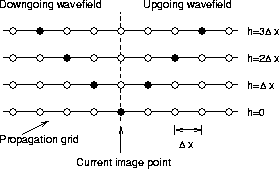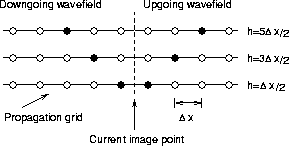![[*]](http://sepwww.stanford.edu/latex2html/cross_ref_motif.gif) ) will image with half-offset spacing
) will image with half-offset spacing
![[*]](http://sepwww.stanford.edu/latex2html/cross_ref_motif.gif) .
Sampling in offset can be refined further by considering
Figure
.
Sampling in offset can be refined further by considering
Figure ![[*]](http://sepwww.stanford.edu/latex2html/cross_ref_motif.gif) ; however, to do so requires imaging onto
midpoints which do not lie on the propagation grid.
; however, to do so requires imaging onto
midpoints which do not lie on the propagation grid.
If the wavefields are sampled with spacing ![]() , then
equation (
, then
equation (![[*]](http://sepwww.stanford.edu/latex2html/cross_ref_motif.gif) ) will image with half-offset spacing
) will image with half-offset spacing
![]() , as shown in Figure
, as shown in Figure ![[*]](http://sepwww.stanford.edu/latex2html/cross_ref_motif.gif) .
Sampling in offset can be refined further by considering
Figure
.
Sampling in offset can be refined further by considering
Figure ![[*]](http://sepwww.stanford.edu/latex2html/cross_ref_motif.gif) ; however, to do so requires imaging onto
midpoints which do not lie on the propagation grid.
; however, to do so requires imaging onto
midpoints which do not lie on the propagation grid.
|
cmpeven
Figure 2 Imaging offsets with ![[*]](http://sepwww.stanford.edu/latex2html/cross_ref_motif.gif) ) alone. ) alone.
|  |
|
cmpodd
Figure 3 Imaging offsets with |  |
This problem is experienced whenever data are transformed from shot-geophone to midpoint-offset space, and no perfect solution exists. A typical workaround is to refine the midpoint grid, and fill empty bins with zeros; however, this doubles the data-volume and hence also doubles the cost of migration. Another alternative is to process even and odd offset separately; the disadvantage of this approach is that each half of the dataset may be undersampled.
Since shot-profile migration works in the shot-geophone domain, these problems may be avoided until after the migration is complete. Migration decreases the data-volume, increases the signal-to-noise ratio, and resolves locally conflicting dips. Therefore, it is easier to resample the data on whatever grid suits the interpreter after migration.